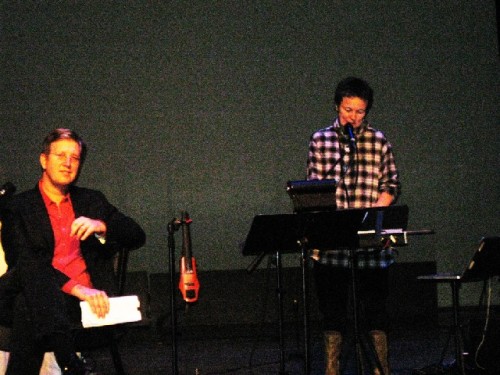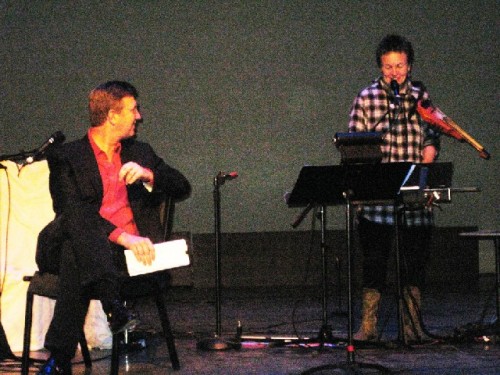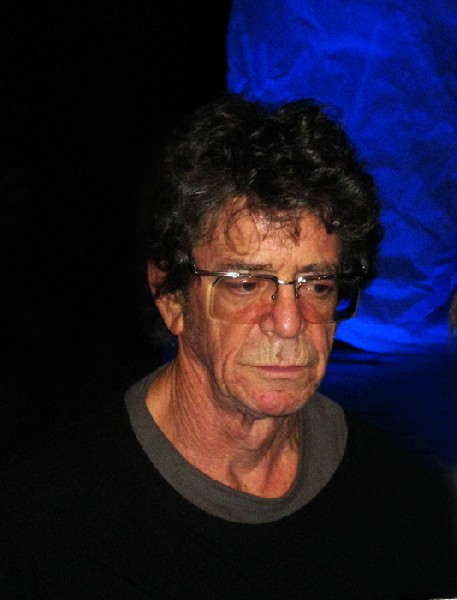Delusion: Laurie Anderson Talks with Joe Thompson at Mass MoCA
Vancouver Winter Olympics Then Williams Feb. 27
By: Charles Giuliano - Jan 21, 2010
The musician, composer and multi-media artist, Laurie Anderson (born June 5, 1947 in Glyn Ellyn, Illinois), has recently been in residence at Mass MoCA working on a new piece Delusion commissioned for the Vancouver Winter Olympics. After a premiere at the Olympics she will return for a performance at the 62 Center at Williams College on Saturday, February 27.As a part of her residence Anderson engaged in a dialogue before a capacity audience at Mass MoCA with its director Joe Thompson. The stage, where she has been refining the visual and multi media aspects of the new work, was sparsely appointed with a back curtain for projections as well as a large sheet of crumpled paper, for a similar purpose, off to one side. There was some electronic and computer equipment on stage.
With her trade mark, spiky hair she was attired in pants, boots and a flannel shirt. The general mood was casual and low key as she exuded friendly charm and a sprightly sense of humor. Mostly she down played the occasion and informed us that she has no great talent for playing the violin and takes a home made approach to the instruments and technology she uses. There was little or no art speak as she conveyed a hands on, intuitive approach to creativity.
It was a refreshing and endearing approach that was warm, charming, funny and inviting to the audience who listened attentively. There was a comfortable, chatty relationship with Thompson who appeared to know her work well while occasionally quoting from extensive notes. From the front row her companion and sometime collaborator, rocker Lou Reed, listened but was not involved in the dialogue.
Despite some 90 minutes of dialogue and a few questions I am still not very clear on just what shape and form Delusion will take. There was a dialogue about its elements and the creative process. We hope to attend the Williams performance and file a report. For now the project seems sketchy. While still a work in progress during the Mass MoCA residence it is not clear just how refined it is just a short time from its scheduled debut in Vancouver.
The program notes passed out for the event state that Delusion is "Conceived as a series of short mystery plays, this work jump-cuts between the everyday and the mythic. Combining violin, electronic puppetry, music and visuals. Delusion is full of nuns, elves, golems, rotting forests, ghost ships, archaeologists, dead relatives and unmanned tankers. It tells its story in the colorful and poetic language that has become Anderson's trademarkÂ…It tells a complex story about longing, memory and identity."
She states that "You begin with a blank mind. There is absolutely nothing in it. Not a single picture. There is a void. No names. The first thing to wander into this mind is a small spotted dog named Terence and his owner, historian and social commentator Fenway Bergamot."
Anderson started the dialogue with an amusing, confusing surreal take on how "I get claustrophobic" and the general hex of being a multi media artist. To get away from the confines of the studio she had been performing on the road with a mix of musicians
"I wrote on the road." She explained. "It's so hard to do like concocting a shaped and sonic record. I played with lots of different people; jazz guys to hip hop groups. And a group of Mongolian throat singers. They use harmonic series which sound like a radio tuned to 30 stations all at once. I heard them play with Chinese two string instruments. There is a tttteeeech throaty whistling sound. (She demonstrated) I combined their harmonics with western instruments. They make hand carved instruments. I heard them perform at a museum and the next day went to their workshop event. I asked them to come to the studio and play on two works. After that, they took an eleven hour flight to Moscow, then an eight hours bus ride. From there they walked three days to get home. They're nomads".
Later Anderson encountered them in Portugal. "I ran into them a couple of hours north of Lisbon in a castle. It was a great concert after which they were walking off into the night. It seems their Russian manager had failed to book transportation back to Lisbon. They were just going to walk. They're nomads. Playing with them I learned a lot about life and time. Playing on the road with different musicians I break out of clichés so it helps to play with different people."
To demonstrate the sound she is working on Anderson offered to play a 40 second clip. She called to a person off stage to help with the computer. She explained using a lot of software for a virtual mixer. "This is a little rig used in the show" she said manipulating a laptop and a device with several foot pedals. "This is the way the show begins."
Having had a brief taste of the sound Thompson said that sitting in while she was rehearsing during the past week "I saw you work through an instrument with eight or nine slider buttons. How many tracks and software are involved in what goes into a 40 second clip like that?"
She replied "There are these little keyboards. I like junky physical stuff so that if it breaks on the road you just throw it away and get another one. As for software it's complicated. There are foot pedals that allow ways to access sound. It is also home made. This is one that has keyboards that you can play with your feet. It's a lot of fun. This violin was designed by Ned Steinberger. You can play it attached to your shoulder and it leaves your hands free to do something else. I'm also learning these new numbers. I prep that while checking out the laptop, while telling a story. I'm tweaking levels and stuff."
Thompson said "So Delusion projects one reality for another."
Anderson explained "It's two stories about donkeys. I don't know why. The first one is a mechanism I've used my whole life to get to do things. Why am I doing anything? It's about the carrot and the donkey. You do this and get that. It's about little bribes and prizes. At some point my donkey died. There was a dead donkey in the dust."
In addition to having a great space to work in it appears that the Berkshires have a direct connection with her. "Being around here I was thinking about Mount Greylock and how it inspired Melville. Looking at the mountain and writing a book about a whale was pretty delusional. I love the Melville quote 'What is a man if he outlives the lifetime of his God?' If it's gone how do you go on if that (God) doesn't exist? This is (Moby Dick) one of a number of stories that answer those questions. It's not obvious about the question.
"In the end it is a lot about editing. What about that is working? It's about that something that jumps out to other people. In my work I can't hang a painting which people can come back and look at a number of times. In performance art it has to work that second. It has to work immediately or not at all.
"The hardest thing is to find a simple line, so you don't know. What I meant about multiple things is trying to not have too many things going on with multi media. It gets confusing. I don't want too much."
In 1999 she performed Songs and Stories from Moby Dick. The work entailed The Talking Stick then a new instrument she designed in collaboration with Interval Research and Bob Bielecki. It is a wireless instrument that can access and replicate any sound. It works on the principle of granular synthesis. This is the technique of breaking sound into tiny segments called grains and then playing them back in different ways. The computer rearranges the sound fragments into continuous strings or random clusters which are played back in overlapping sequences to create new textures.
"When I did Melville" she said, "His book didn't need to be multi media music and stuff. What for? I thought if Melville found out about it he would come and kill me. When I was working on Melville someone brought me Melville's Bible. It was filled with pencil notes and drawings. While working on Moby Dick he was reading Shakespeare and the Bible. The marks were erased by his wife. She thought he was defiling the family Bible. A friend got it for me at Sotheby's He took it to the FBI to see if we could read what was erased. They said it was too old.
"I am looking at it with a magnifying glass. I found something in Isaiah about the leviathan. It is an image of a whale as a snake. It's his Garden of Eden. It works out ideas of good and evil. It's a negative hex for me. I'm too much in love with the book and couldn't make something out of it. And swore that I would write my own stuff after that."
She was asked if the Bible had inspired her. "Bible stories. The first I heard was from flannel back people. I was surprised as a kid to hear adults talk about talking snakes. Adults. Wow. Talking snakes. I was entranced but thought they were mad. I loved that. I realized adults are crazy and thought this is just fantastic. Those are great stories. Who are you? Where do you come from? How do you explain time, power and love? Where do you go after this? How did the world begin? Plus they had a really big palette. Everything was talking like bushes and every living thing."
Again Anderson got out of her chair to demonstrate some of the visual multi media elements she was working on. "We arrived with little projectors" she said. "I like the ability to split and fracture images. These are pieces of the set (crumpled paper backdrop). They become all kinds of different things. We can get lost in their world. It gets complicated, different ways to build a world. We have 27 scenes and we build each one visually. I haven't been working on text or music here just the way things look. It's very home made with homemade cameras.'
Thompson: "So you arrived with video clips of little mini scenes. And the chalk drawings. Did you do those? (She nods yes) Which are very casual and sketchy. You can put them everywhere for the moment. How things get bent. Drawings and video. How many?"
"We started with a hundred clips of various things" she said. "It was just a story about nine hours long. We have lots of stories and the stories went into the story bin. I have two people on the story team as it relates to the theme of Delusion. There are free floaters that get glued to images. A lot of things can be too much. You get overwhelmed. It scares me. I like things that are simple. Keeping it simple is important. For the last five days the point is to tell an interesting story with pictures or sound. Sometimes there are dead ends and sub plots."
Thompson discussed the insight and impact of working to install the Sol LeWitt building on the Mass MoCA campus. This prompted him to ask "If there was a museum for Laurie Anderson what would it be like?"
She talked about the beauty of the LeWitt work and the power of the installation adding that "You also feel the generosity of that artist. He was my teacher in school. (MFA from Columbia University in 1972.) I was trained as a sculptor. Initially I was making boxes with sound inside. We got together in Rome. We were there for a show and there was a delay. We expected it would open in a couple of days. They informed us the show would be delayed until three weeks from now. I didn't know then what it was like to work in Italy. Sol said let's just walk around Rome with no plan for three weeks. One rainy drizzly day we walked into a piazza and there was an artist painting. Sol said 'It takes dedication to paint on a day like this.' He loved asking what we are here for. I think of that a lot."
In 2002 she was the subject of a retrospective at the Musee d'art contemporain de Lyon. Regarding the notion of an Anderson museum she said "At first I didn't try to save my work other than some photos and videos. Then I thought that yes it is good for you to have a retrospective. Marina Abramovic is a performance artist who is about to open a retrospective at MoMA. She has hired artists to recreate her pieces which are one way of doing it. Some of the works involve endurance from the Chris Burden School of performance. We have talked a lot about how to preserve performance works.
"I first saw her when she was partners with Ulay" she said. "There was an opening of an exhibition in Italy (June, 1977 at the Galleria d'Arte Moderna Bologna)." The artists were nude on opposite side of the entrance to the museum. Visitors had to squeeze between them and physical contact was unavoidable. The decision was whether to face and rub against the nude body of the man or the woman. Anderson described another piece in which the artists started from either end of the Great Wall of China. They met in the middle to break up and never see each other again. Well, that's one way of finding closure at the end of a relationship.
She discussed the range of her work. "At DIA I showed a lot of things of extreme scale. I was working on projects big and small for this exhibition. I was also doing a singing tree for a garden in Basel as part of a big Frank Gehry building and park. I thought let's do some kind of sound thing there with symphonic trees. There was all of this elaborate program. It took a couple of years to get it together. There are some speakers that are very tiny and others not. The sound travels through the park."
Being on location can inspire specific works. Spending time in the Berkshires and contemplating Mount Greylock made her think of Melville and its influence on Moby Dick. While working on a project with a curator in Milan in a former monastery she was surprised when up on its roof. It seems that the museum was located next to a maximum security prison. She began to think of a project that connected these dramatically different elements. This led to the idea of a live video feed of a prisoner onto the wall of the apse. The prisoner would sit on a stool and be projected into the museum during its hours of operation.
She found a willing prisoner but there was a problem as it was against Italian law for a prisoner to be photographed. That seemed to nix the project seemingly to her relief. Then the Attorney General offered an exception to the law. By then she had moved on but managed to create the work at the Whitney Museum using a prisoner from Sing Sing.
When she asked the prisoner why he was willing to participate she was surprised by the answer. For him the video project was a "virtual escape." The audience laughed when she conveyed "I found the right guy."
Thompson opened the dialogue to a couple of questions from the audience.
"Do you every play music not yours like Bach etc?"
"I'm not a very good violinist" she said. "I don't have great chops. I only play acoustic if my electric violin is broken. I only have solid body violins and there is no resonance built in. A lot of violins I design are not really playable. Some have speakers inside. One has a tape instrument playback head glued to the bridge. The bow was made with audio tape. I made it when I was doing the engineering myself. It was the days of tape. I would cue it back up and thought why not combine it into an instrument. A lot of things have that kind of hands on genesis. Another thing was a table designed for MoMA. It came about because I was trying to work with an electric typewriter. It was so stupid I put my head in my hands. I was so depressed. I decided to build a singing table with sound driven up through rods."
"Tell us about your trek to Everest?"
"Not Everest. The Himalayas. There was a lake which offered clues to the monks to find the next Dali Lama. I wanted to see it. On that trek I came down with altitude sickness. I had 105 fevers for five days. We got lost. There was a fight between the spiritual leader and the mountain guide. I backed the spiritual leader. What a mistake. They carried me down from the mountain for several days. Normally the Sherpas are very quiet but one talked to me non stop for days. At one point when we stopped I heard them discussing how they should have a ritual for the dead. They thought I wouldn't make it. I came to realize it was the power of his voice that kept me alive." Indeed.





